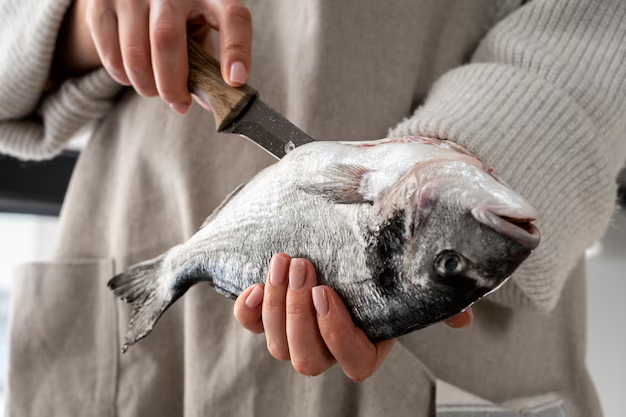Safeguarding Your Seafood: How Long Can Raw Fish Stay Fresh in the Refrigerator?
Fresh, raw fish is not just a culinary delight; it's a nutritional powerhouse offering omega-3 fatty acids, protein, and essential vitamins. However, ensuring that your fish remains fresh and safe for consumption involves more than just a quick trip from supermarket to kitchen. Proper storage is crucial in maintaining its quality and avoiding foodborne illnesses. So, how long can you store raw fish in your refrigerator before it goes bad? Let's dive into this ocean of facts to keep your meals delicious and safe!
Understanding Raw Fish Shelf Life 🐟
When it comes to storing raw fish, the clock starts ticking the moment it's harvested. The freshness of fish can degrade rapidly, transitioning from prime to spoiled if not handled and stored correctly. Typically, raw fish can last in the refrigerator for about 1 to 2 days. This general guideline assumes that the fish has been handled correctly and kept at a consistent refrigeration temperature of below 40°F (4°C).
Factors Affecting Freshness
- Type of Fish: Oily fish, like mackerel, salmon, or sardines, tend to spoil faster due to their fat content compared to leaner species like cod or haddock.
- Humidity and Temperature: Consistency in refrigeration temperature plays a vital role. Any fluctuation can accelerate spoilage.
- Initial Freshness: The freshness when purchased is pivotal. Fish bought directly from reputable sources tends to last longer.
- Packaging Practice: Vacuum-sealed packaging can help extend shelf life by reducing exposure to air and bacteria.
Recognizing Spoilage: When is It Time to Discard? ⚠️
Proper identification of spoilage signs is essential to avoid the risks associated with consuming bad fish. Here’s what you should look out for:
Appearance
Fresh fish should have a natural sheen, with moist and reflective skin. However, once it starts to spoil, you'll notice:
- A dull or slimy film on its surface.
- Any discoloration, such as browning or yellowing.
- Cloudy eyes, in the case of whole fish.
Smell
Fresh fish has a slight, ocean-like odor. If your fish smells overly fishy, sour, or like ammonia, it’s best to err on the side of caution and discard it.
Texture
Press the fillet lightly. Fresh fish should be firm. An overly soft or mushy texture suggests the fish has started to break down, signaling spoilage.
Best Practices for Storing Raw Fish 🧊
Proper storage techniques are crucial to extend the shelf life of your raw fish and maintain its quality.
Refrigeration Tips
- Seal and Contain: Store fish in airtight containers or wrap it tightly in plastic wrap to minimize air exposure.
- Temperature Check: Ensure your refrigerator is set below 40°F. It’s a small step that makes a big difference.
- Location Matters: Place fish on the lowest shelf to prevent cross-contamination with other foods and to maintain a consistent temperature.
Freezing as an Alternative
If you’re not planning to use the fish within 1-2 days, freezing is a reliable option to preserve it for months. Before freezing:
- Pat dry the fish with a paper towel to remove excess moisture.
- Wrap individually in plastic wrap or foil, followed by a freezer-safe bag to prevent freezer burn.
- Label your packages with dates so you can keep track and rotate stock efficiently.
Thawing Your Frozen Fish Correctly ❄️
Once you're ready to use your frozen fish, thawing it properly is key to preserving its texture and flavor.
- Slow Thawing: Ideally, thaw fish in the refrigerator overnight.
- Quick Method: If in a rush, submerge the sealed fish in cold water.
- Avoid Microwave Thawing: It can cause uneven heating and pre-cook parts of the fish.
Facts about Refreezing
While it’s generally not recommended to refreeze fish, if necessary, ensure it was thawed in the refrigerator. This method ensures temperatures haven’t risen above the safe zone, reducing bacterial growth risks.
Health Risks of Consuming Spoiled Fish 🚫
Consuming spoiled fish can result in severe foodborne illnesses such as scombroid poisoning or ciguatera. To prevent these risks, always adhere to the guidelines for storing, examining, and handling raw fish carefully.
Symptoms to Watch
- Scombroid Poisoning: Characterized by flushing, rashes, and diarrhea.
- Ciguatera: Can cause nausea, vomiting, and neurological symptoms.
Seek medical attention if you suspect food poisoning from consuming fish.
Tailoring Your Approach: Different Types of Fish and Their Storage Needs
Different types of fish require unique considerations due to variance in their oil content and texture.
Lean vs. Fatty Fish
- Lean Fish: These include species like cod and haddock. They typically withstand slight temperature variations better but also dry out quicker.
- Fatty Fish: Salmon and mackerel are renowned for their rich oils, making them robust in flavor but prone to faster spoilage.
Specialized storage can help both types maintain their quality. For example, using a vacuum sealer for fatty fish can help prevent the oils from turning rancid.
Conclusion
Ensuring the freshness and safety of your raw fish needs a vigilant approach. By understanding the nuances of refrigeration times, recognizing spoilage signs, and employing best storage practices, you can enjoy the full flavor and health benefits raw fish offers. Whether storing it in the fridge for a couple of days or turning to your freezer for extended preservation, these tips will help you manage this delicate but rewarding ingredient like a pro.
With this knowledge, you're well-equipped to handle raw fish storage like a seasoned chef! Enjoy your seafood adventures and savor the flavors with peace of mind.
